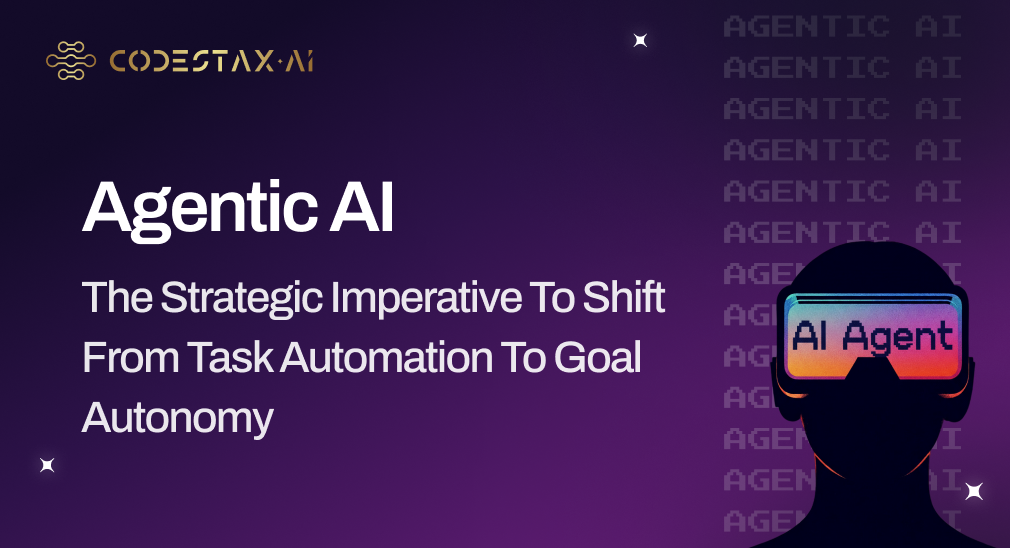- Home
- Platforms
- Services
- Our Story
- Join Us
- Solutions
- About
- Resources
- Connect Now
How can we assist in your digital excellence journey

Connect with us
Get more updates and further details about your project right in your mailbox.
The best time to establish protocols with your clients is when you onboard them.

Lorem ipsum dolor sit amet, consectetur adipiscing elit. Suspendisse varius enim in eros elementum tristique. Duis cursus, mi quis viverra ornare, eros dolor interdum nulla, ut commodo diam libero vitae erat. Aenean faucibus nibh et justo cursus id rutrum lorem imperdiet. Nunc ut sem vitae risus tristique posuere.
While the integration of Artificial Intelligence (AI) is now ubiquitous across contemporary business operations, a significant paradigm shift is emerging. Organizations are beginning to elevate their automation strategies from simple, rule-based systems to Agentic AI, systems capable of autonomously orchestrating complex, end-to-end workflows.
This evolution is not merely incremental. As Satya Nadella, CEO of Microsoft, observed, "AI agents will become the primary way we interact with computers in the future. They will be able to understand our needs and preferences, and proactively help us with tasks and decision making." This development represents a strategic mandate for exponential productivity returns across knowledge-intensive sectors.
Many enterprises are operating within a phase of "AI confusion," characterized by the misapplication of tools. The widespread reliance on traditional Robotic Process Automation (RPA) for tasks that demand complex cognitive functions proves inefficient.
The limitation of RPA lies in its inherent functional rigidity. As analysts at Gartner suggest, RPA bots are "brilliant instruction followers," while AI agents are "outcome pursuers." RPA adheres to a static, predefined script, making it effective for predictable, repetitive processes. However, when faced with environmental variability, complex exceptions, or tasks requiring genuine judgment, the model fails, necessitating human escalation.
The distinction between conventional automation and Agentic AI is centered entirely on agency—the capacity to self-initiate action, plan, and execute choices toward a designated objective. Bill Gates, emphasizing the magnitude of this change, stated that agents "are also going to upend the software industry, bringing about the biggest revolution in computing since we went from typing commands to tapping on icons."

An AI Agent thus operates as an autonomous digital collaborator, not just a tool. It takes decisive action, maintains focus on the goal, reasons through complex problems, and integrates across enterprise systems.
The highest return on investment (ROI) for Agentic AI is realized through the strategic delegation of complex, multi-step processes that currently consume disproportionate human capital.
McKinsey & Company notes that agents "combine autonomy, planning, memory, and integration to shift gen AI from a reactive tool to a proactive, goal-driven virtual collaborator," transforming processes in five key ways: accelerating execution, increasing adaptability, enabling deep personalization, bringing elasticity to operations, and increasing resilience.
Specific high-impact applications include:
To maximize resource allocation, potential Agentic AI use cases must be validated against three objective criteria:
The challenge of adopting this technology is less technical and more strategic. As McKinsey highlights, the main challenge "won't be technical—it will be human," focusing on governance, trust, and cohabitation. Strategic leaders must address:
The future of enterprise productivity hinges on autonomy. By strategically delegating complex processes to specialized AI Agents, organizations empower their workforce to redirect focus toward strategic planning, creativity, and high-value relational activities. This shift is the strategic imperative for realizing exponential efficiency gains in the evolving AI era.
